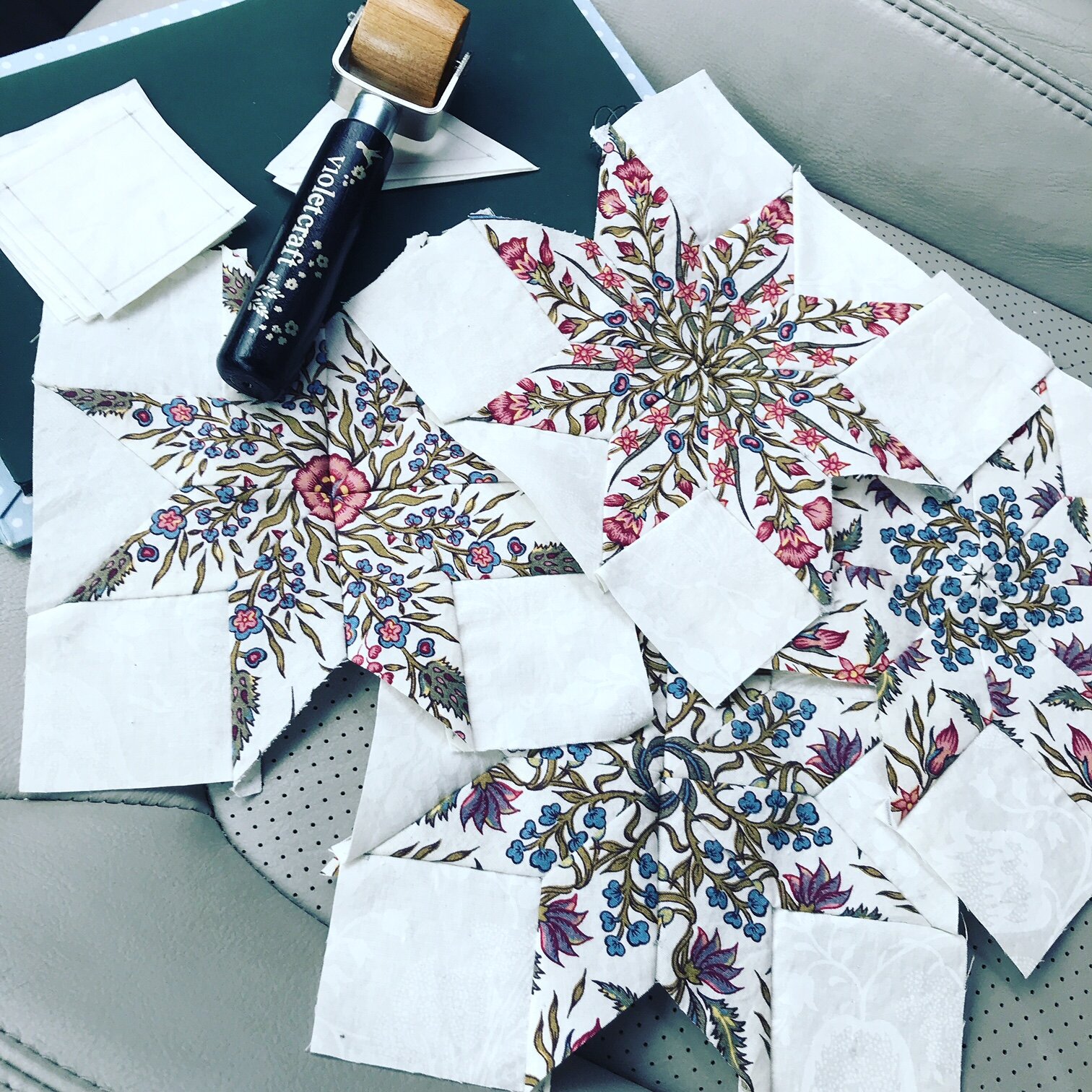Today is the Day I Admit to a Secret Work in Progress: Dutch Delight
I realized that I missed a WIP when I first started this blog. It seemed nice and neat to “only” have one knitting project and two quilts in progress. The two quilts quickly became three, and now the three is actually four. This is yet another project I’d like to finish up before I start Antique Wedding Sampler.
This project was started three (or even four) years ago because I wanted a hand piecing project to work on when I was waiting for my kids at their various activities. I had made fairly good progress, then COVID hit, and my kids had no activities, then my daughter got her driver’s license, and I had no need to drive anyone anywhere! This project languished. This is an older pic of some stars being made in my minivan at violin practice.
I’m sure I came across this project when I was researching dutch chintz reproduction fabrics and projects. My google search pulled up the following blog post by a UK quilter named Susan Briscoe. She photographed and blogged about this gorgeous quilt made from dutch reproduction fabrics that won recognition at the large Malvern quilt show in the UK in 2009. According to Susan the quilt was made by a British quilter named Maureen Crawford who bought the fabric as a kit in Amsterdam, Netherlands at Den Haan & Wagenmakers (of Petra Prins fame). You can see images of Maureen’s amazing quit in the blog post link above, but here is the quilt worked up in Electric Quilt to give you an idea of the layout.
The quilt design cleverly uses a single border pattern of this chintz fabric.
You fussy cut each star to create rows of 8-pointed stars set on-point. The green leaf border is used for sashing, then use the remaining border print as is for your quilt border. In Susan’s blog post, Maureen Crawford had indicated that getting the border to fit was quite tricky. If she thinks it’s tricky, I will probably think it is impossible, but, since I’m still not at the final borders, I’m going to think positive thoughts.
After some research, I realized this border fabric (called La Provence) is still available at Dutch Reproduction Fabrics in the Netherlands. I fell in love with this quilt, bought myself some fabric, and got started. The fabric comes with a glazed finish and is sold in 60” width (makes the price feel a little bit better!). If you don’t like the glazed finish, simply wash the fabric. Read here for more information about story of Dutch Reproduction Fabrics. They print and produce their fabrics at a factory in Goor, The Netherlands using historic designs. I also bought their tone on tone Grapes & Tulips in Ecru for the background and a small amount in olive green for the sashing cornerstones.
Pre-Covid the fabric arrived within a week, amazingly fast shipping. During Covid I placed an order for some different fabric, and shipping took 3x as long. Just a heads up to anyone ordering. Plan for int’l shipping to take a month right now. They have great customer service and can answer questions in multiple languages. Do not be afraid to order or ask questions!
Resources for this project:
Fabric:
Main border print: La Provence in Ecru
Background: tone on tone Grapes & Tulips in Ecru
Sashing cornerstones: Grapes & Tulips in Olive Green
Other Dutch chintz reproduction border prints (60” width, glazed)
Other Dutch chintz reproduction border prints (44” width, unglazed—”typical quilting cotton”)
Tools & Notions:
** A quick note about this project. As far as I can tell, there is no “Dutch Delight” pattern available for sale. I don’t’ know if Maureen Crawford made up the name “Dutch Delight” or if that was the name of the pattern she received from Den Haan & Wagenmakers. While this is a simple quilt layout, and an experienced quilter can easily come up with their own pattern, I know I like to have the pattern for fabric requirements. I am happy to link to the pattern if it is still available for sale.



